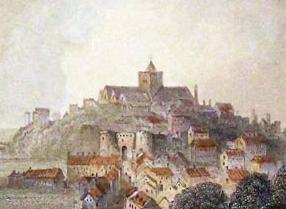1030 – Rye (included in the Manor of Rameslie) given to the Abbots of Fecamp in Normandy
1100 – La Rie – La Rye
1105 – Church: Hospital of St. Bartholomew
1141 – Mint – King Stephen
1194 – Town Walls commence on North side of Town with the Town Ditch
1247 – Became the Royal Manor of Rye
1249 – Ypres Tower built for defence
1250 – The sea flowed twice without ebbing and the River Rother hitherto entering the sea at New Romney, now flows past Rye making the Town very important.
“The Cinque Ports” were enfranchised in the time of Edward the Confessor (before the Conquest) and in 1287 received its Charter of Confirmation (the five ports were Sandwich, Dover, Hythe, Romney and Hastings). This powerful Confederation supplied ships for the defence of the Country and enjoyed many unique privileges. Rye and Winchelsea were added to the original Five Ports as “the Two Ancient Towns”.
1254 – Ypres Tower
1263 – Friars of the Sack
1287 – Old Winchelsea overwhelmed Rother – Romney – Rye
1289 – Borough of Rye incorporated by Charter.
1329-54 – Walls were built: Land Gate, Strand Gate, Baddings Gate and Postern Gate
1339 – French burn 52 houses and 1 mill
1345 – 1st Town Hall
1347 – Brothers of Repentance dissolved
1360 – French invade Rye again
1377 – Rye sacked by the French, all wooden buildings burnt to the ground
1350-75 – Baddings Gate and East Cliff destroyed by the sea
1364 – St. Augustines Friary on East Cliff
1379 – La Hastone Friars Early 15th Century old Hospital manor of Lewisham- Leasam
1400 – Rye appointed to supply fresh fish to the King’s table regularly by “rippiers” (30 horses kept for this purpose)
1430 – Ypres Tower sold to John de Ipyres
1518 – Rye bought Ypres Tower for £26
1528 – St. Augustines Friary on East Cliff suppressed
1539 – Camber Castle built at a cost of £23000
1563 – and 1580 Plague badly hits the Town
1572 – 1574 Huguenots land at Rye after the massacre of St. Bartholomew and settle in the area around the Town still called “Rye Foreign”
1573 – Queen Elizabeth visited the Town and called it “Rye Royal”
1588 – Rye sends a frigate loaded with stores out to the Channel to assist Admiral Sir Francis Drake when chasing the Armada
1611 – First Dungeness Light house
1639 – Peacocke School. Building starts
1643 – Camber Castle abandoned
1644 – The Grammar School erected by Mr. Thomas Peacock is completed 1682 – Samuel Jeake (an early non-conformist) excommunicated for preaching sedition
1700 – Tillingham Ferry bridge
1733 – Water Tower
1758 – Wesley visits Rye and Winchelsea
1767 – Strand Gate was demolished
1773 – John Wesley visits Rye and preached against “that accursed thing smuggling”
1789 – New chapel opened
1803 – Napoleon threatened invasion. Military Canal (from Pett to Hythe) dug as means of defence
1838 – Two Steam Packets ran between Rye and Boulogne
1850 – Railway opened. 23 May.
1877 – “Boulders” taken up from High St. East Street and Lion Street to help the unemployed
1907 – Peacocke School (The Old Grammar School) was closed
1940-44 – Rye badly damaged by enemy bombing and by numerous “doodle bugs” on the Borough
1965 – “Rye’s Own” first published.
“Rye’s Own” April 2001
All articles, photographs and drawings on this web site are World Copyright Protected. No reproduction for publication without prior arrangement. © World Copyright 2015 Cinque Ports Magazines Rye Ltd., Guinea Hall Lodge Sellindge TN25 6EG
All articles, photographs and drawings on this web site are World
Copyright Protected. No reproduction for publication without prior
arrangement.
© World Copyright 2015 Cinque Ports Magazines Rye Ltd., Guinea Hall
Lodge Sellindge TN25 6EG
